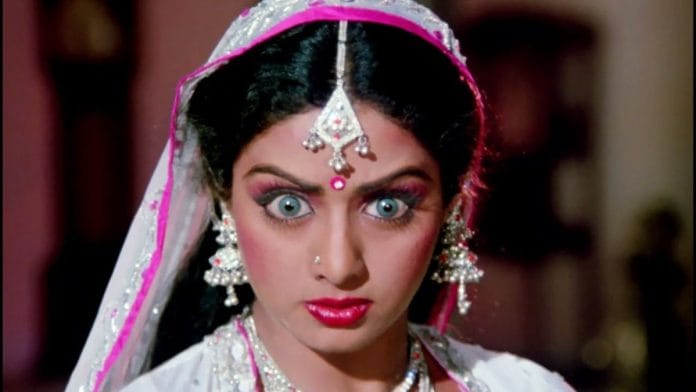New Delhi: Ekta Kapoor’s popular TV series Naagin is set to return for the seventh year, and there is a buzz about who might play the next lead. What most people don’t know is that long before the show became a hit, Sridevi made playing the icchadhari naagin or shape-shifting serpent, iconic with her performance in Nagina (1986).
Since then, many have tried their hand at this fascinating sub-genre, in both television and films. Before Sridevi, there was Nagin (1976), where the role of the serpent was played by Reena Roy, and another movie by the same name with Vyjayanthimala in it. All of these films were blockbusters, establishing the formula as almost fail-safe.
Harmesh Malhotra’s Nagina brought together the pair of Rishi Kapoor and Sridevi, who would later also deliver the hit Chandni (1989). Nagina tells the story of Rajiv (Rishi Kapoor), a London-returned wealthy heir who lives with his mother at a palatial house near a village. One day, he meets the mysterious orphan Rajni (Sridevi) in a dilapidated old haveli. Rajni, dressed in white, walks in an eerie manner across the hallways, while Rajiv follows her.
The chance encounter with Rajni leaves Rajiv deeply intrigued and attracted to her, so much so that he dismisses the marriage proposal with Vijaya (Komal Mahuvakar). The two fall in love with each other, before Rajiv’s mother, who is unhappy with their relationship, comes in the way.
Naagin without VFX
The movie takes on the idea of the community known as snake charmers, residing in North India, and weaves a story of good vs evil, blending myth and folklore with the over-the-top nature of Bollywood masala films of the decade. It also incorporates the festival of naag panchami, which celebrates snakes.
In the absence of VFX too, Nagina manages to keep the thrill intact, as the rapid camera switches from the image of Sridevi to a cobra, implying that Rajni is in fact a cobra, and who would not spare anyone harbouring evil thoughts. A change in the colour of Rajni’s pupils from black to blue is the other way of showing that she is the shapeshifter.
In one of the early scenes, she kills a man who tries to assault her. The movie is a right mix of romance, intrigue and fantasy. There is also a hospital scene where a ‘good’ cobra and a ‘bad’ cobra enter a fight, almost like how heroes and villains in human forms do.
Also read: Kal Aaj Aur Kal brought Kapoors together on big screen. That’s all it’s remembered for
Sridevi magic
In his book, When Ardh Satya Met Himmatwala: The Many Lives of 1980s Bombay Cinema, Avijit Ghosh mentions what film critic Deepa Gehlot said about Sridevi. “This girl has brought with her the oomph of Mumtaz, the discipline of the South, talent [Sadma] and charm entirely her own and joined the race for superstardom which she shows all signs of winning,” wrote Gehlot.
Sridevi commands every scene she appears in, with her acting and her signature smile. Dressed in Indian traditional wear, with gajras, and bindi, she perfects the duplicitousness of being the ‘good bahu’ and the avenger, without making anyone in the family suspicious. Despite Rishi Kapoor being part of the movie, Sridevi easily emerges as the bigger star, acing not just romance but also revenge.
Her scenes with Amrish Puri, who plays the antagonist sadhu Bhairo Nath are powerful as they lock horns. And Sridevi’s dance in the song ‘Main teri Dushman’, close to the end of the movie, is one of her best dance performances.
In 2013, Sridevi was given the Filmfare Special Award for her performances in Nagina as well as Mr. India (1987).
The film was a massive box office success, like its predecessors in the genre, and managed to earn Rs 4.75 crores. This prompted Malhotra to make a sequel, Nigahen: Nagina part II (1989). It starred Sridevi with Sunny Deol. Sridevi plays the daughter of Rajni and Rajiv and Deol is a tantrik. But the film tanked at the box office.
In fact such was the terrible performance of Anupam Kher who had played the antagonist in the movie, that guests started walking out or making excuses, during the screening of the film organised by him.
(Edited by Ratan Priya)






